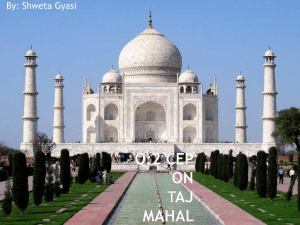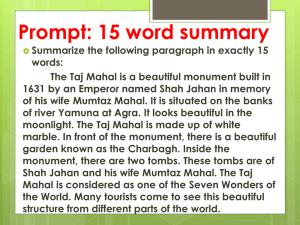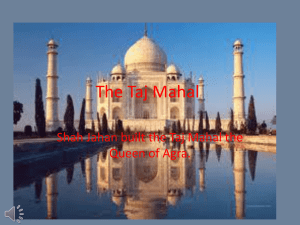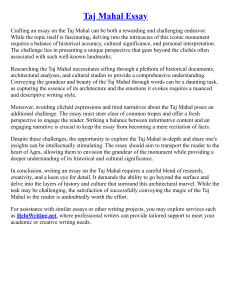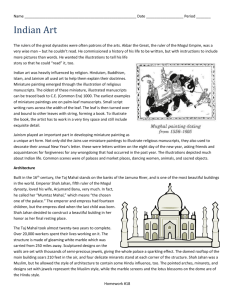The Taj Mahal - The Big Read
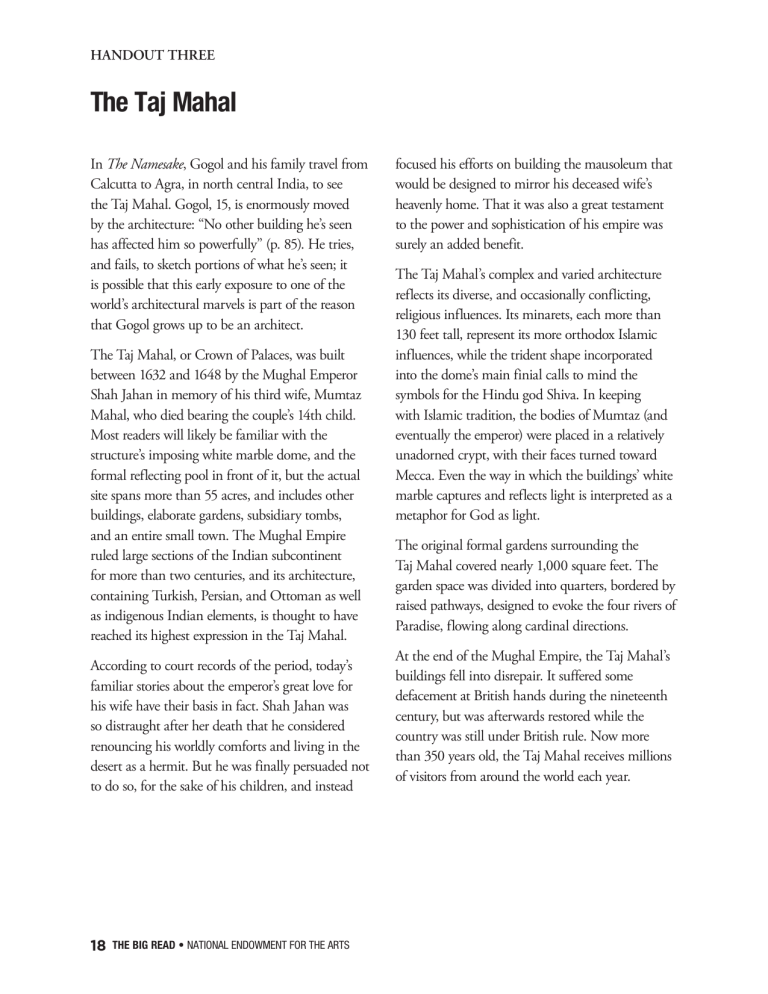
HANDOUT THREE
The Taj Mahal
In The Namesake, Gogol and his family travel from
Calcutta to Agra, in north central India, to see the Taj Mahal. Gogol, 15, is enormously moved by the architecture: “No other building he’s seen has affected him so powerfully” (p. 85). He tries, and fails, to sketch portions of what he’s seen; it is possible that this early exposure to one of the world’s architectural marvels is part of the reason that Gogol grows up to be an architect.
The Taj Mahal, or Crown of Palaces, was built between 1632 and 1648 by the Mughal Emperor
Shah Jahan in memory of his third wife, Mumtaz
Mahal, who died bearing the couple’s 14th child.
Most readers will likely be familiar with the structure’s imposing white marble dome, and the formal reflecting pool in front of it, but the actual site spans more than 55 acres, and includes other buildings, elaborate gardens, subsidiary tombs, and an entire small town. The Mughal Empire ruled large sections of the Indian subcontinent for more than two centuries, and its architecture, containing Turkish, Persian, and Ottoman as well as indigenous Indian elements, is thought to have reached its highest expression in the Taj Mahal.
According to court records of the period, today’s familiar stories about the emperor’s great love for his wife have their basis in fact. Shah Jahan was so distraught after her death that he considered renouncing his worldly comforts and living in the desert as a hermit. But he was finally persuaded not to do so, for the sake of his children, and instead focused his efforts on building the mausoleum that would be designed to mirror his deceased wife’s heavenly home. That it was also a great testament to the power and sophistication of his empire was surely an added benefit.
The Taj Mahal’s complex and varied architecture reflects its diverse, and occasionally conflicting, religious influences. Its minarets, each more than
130 feet tall, represent its more orthodox Islamic influences, while the trident shape incorporated into the dome’s main finial calls to mind the symbols for the Hindu god Shiva. In keeping with Islamic tradition, the bodies of Mumtaz (and eventually the emperor) were placed in a relatively unadorned crypt, with their faces turned toward
Mecca. Even the way in which the buildings’ white marble captures and reflects light is interpreted as a metaphor for God as light.
The original formal gardens surrounding the
Taj Mahal covered nearly 1,000 square feet. The garden space was divided into quarters, bordered by raised pathways, designed to evoke the four rivers of
Paradise, flowing along cardinal directions.
At the end of the Mughal Empire, the Taj Mahal’s buildings fell into disrepair. It suffered some defacement at British hands during the nineteenth century, but was afterwards restored while the country was still under British rule. Now more than 350 years old, the Taj Mahal receives millions of visitors from around the world each year.
18 THE BIG READ • NATIONAL ENDOWMENT FOR THE ARTS

